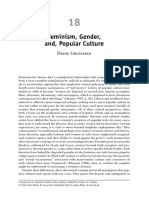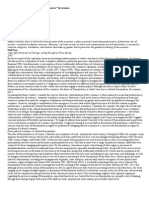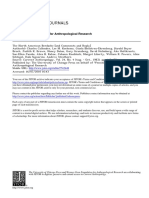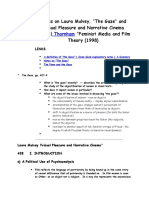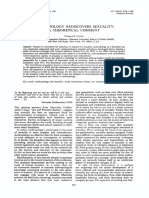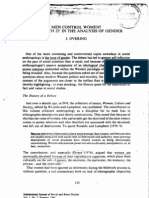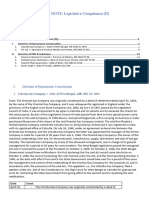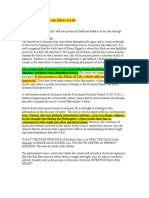Mary Devereaux
Mary Devereaux
Uploaded by
radebayoCopyright:
Available Formats
Mary Devereaux
Mary Devereaux
Uploaded by
radebayoOriginal Description:
Copyright
Available Formats
Share this document
Did you find this document useful?
Is this content inappropriate?
Copyright:
Available Formats
Mary Devereaux
Mary Devereaux
Uploaded by
radebayoCopyright:
Available Formats
Mary Devereaux, "Oppressive Texts, Resisting Readers, and the Gendered Spectator: The New Aesthetics" Discussion of feminism
and its relationship to traditional aesthetics No vision is a neutral vision. In fact, gender plays an important role in formulating the expectations we have for our representations of the world. The "male gaze" is a way of looking at the world from the perspective of the patriarchy, a social system marked by the supremacy of the father and the legal dependence of wives and children. Women depend on men for status, privilege, and identity. This oppression occurs on both the material and symbolic levels. Women are oppressed not only economically and politically, but in the forms of reasoning, signifying, and symbolical exchange of our culture. Art is such a form. It inscribes a masculinist discourse which we then learn to reproduce in our everyday lives. Art reflects the conditions of life, but also helps to establish and maintain them. In categorizing art with other forms of patriarchal oppression, feminism rejects the division of art and politics which is basic to Anglo-American aesthetics. But it presents other challenges as well: different and difficult jargon and methodology, overthrow of deeply entrenched assumptions about the universal value of art. Also charges that it is impossible to simply extend aesthetics by "adding on" feminism, as work by Goodman, Danto, and Dickie was added to the body of theory. Male Gaze - how it works in film, a sample of feminist aesthetics Three different "gazes" which function together. filmmaker Institutions of filmmaking remain largely populated by men - so the gaze is maledominated. This control matters because it builds in a preference for certain kinds of films. Characters within the film / the film text Content/stories of traditional Hollywood films define value of women as their value to men. Hollywood film functions as a recuperative strategy designed to return wayward women to the fold. spectator Traditionally confined to point of view of the narrative hero (usually male). Spectator has no choice but to identify with the active, male protagonist. Women perform for the camera, and thus for the spectator. Conditions for oppression To be fully oppressive, male gaze needs physical, social, emotional "backup" female narcissism, at some level, activated by being looked at: women must have internalized a certain assignment of positions
How the male gaze is oppressive objectification: male gaze takes an object. In this respect it is no more or less objectifying than any other gaze (perspective). Objectification does not constitute oppression. dehumanization: male gaze treats people as objects of aesthetic (possibly erotic) contemplations. This is also not necessarily oppressive. debasement: only one of these three which constitutes oppression. Not implied by the other two. Male characters may be objectified or aestheticized, even portrayed in demeaning or "less than fully human" ways. But they are not debased in the larger sense of the word, because men do not lack power offscreen. Debasement requires "backup". Women's secondary positions occur offscreen as well as on, so they are debased. effect on the spectator Film presents its telling as absolute truth. The effect of film depends on narrative illusion: cannot call attention to itself as a story. Some allege that this encourages passivity of the viewer. unconscious mechanisms involved Voyeuristic pleasure psychoanalytic approach Rests on assumption that film reflects the psychical obsessions of the society which produces it. Narrative cinema provides spectator with two sources of pleasure scopophilic: pleasure of viewing another as an erotic object identification with the ego-ideal (male protagonist, usually) unpleasure Women represent castration threat, which is met by domestication, death, or fetishization. what this means for aesthetics Feminism has succeeded in placing gender on the agenda of things which are of relevance to aesthetics. It seeks to replace long-standing assumptions with new ways of thinking about art and our relationship to it. rather than being autonomous object, art is situated in everyday realm of social and political praxis art is not necessarily universal (denial that artworks or criteria of judgment are value-neutral) reconsideration of relationship to established artistic traditions reading/viewing no longer neutral activities: social and historical placement of
spectator affects meaning derived from text solutions Art has a potential for harm. Other than censorship, what other strategies to counteract/combat this harm are there? new type of art, new traditions rereading
You might also like
- JOHN SHARP - Works of Game - On The Aesthetics of Games and ArtDocument157 pagesJOHN SHARP - Works of Game - On The Aesthetics of Games and ArtDavid Serna Holguin100% (2)
- Essay On Midday For HDDocument3 pagesEssay On Midday For HDLama Hammoud100% (1)
- MYP Arts Sample Unit Plan PDFDocument192 pagesMYP Arts Sample Unit Plan PDFiLoveQuran100% (1)
- Marshall, Claire - The Politics of Self-Mutilation Forms of Female Devotion in The Late Middle AgesDocument11 pagesMarshall, Claire - The Politics of Self-Mutilation Forms of Female Devotion in The Late Middle AgesPabloGarciaNo ratings yet
- Shakespeare Division of ExperienceDocument4 pagesShakespeare Division of ExperienceSigi GiuliaNo ratings yet
- Feminism, Gender and Popular CulturesDocument18 pagesFeminism, Gender and Popular CulturesALINA DONIGA .No ratings yet
- Miriam Hansen-WPS Office - 095354Document46 pagesMiriam Hansen-WPS Office - 095354Arya BNNo ratings yet
- The Classic Theoretical View of How Women Are Represented in MediaDocument3 pagesThe Classic Theoretical View of How Women Are Represented in MediaEllie BuchanNo ratings yet
- Cultural FeminizationDocument12 pagesCultural FeminizationdonnakishotNo ratings yet
- Gender Religion: Tfu /, FDocument21 pagesGender Religion: Tfu /, FJack MitchellNo ratings yet
- 1957 - Sheriffs and McKeeDocument15 pages1957 - Sheriffs and McKeeDebbie.Jones.VNo ratings yet
- Sedgwick 3AA3 RevDocument20 pagesSedgwick 3AA3 RevSNasc FabioNo ratings yet
- 4.6 - Balbus, Isaac D. - Disciplining Women. Michel Foucault and The Power of Feminist Discourse (En)Document19 pages4.6 - Balbus, Isaac D. - Disciplining Women. Michel Foucault and The Power of Feminist Discourse (En)Johann Vessant RoigNo ratings yet
- The North American BerdacheDocument29 pagesThe North American BerdacheAngelaNo ratings yet
- UNIT FOUR 1 Nude vs. NakedDocument25 pagesUNIT FOUR 1 Nude vs. NakedMa. Christella LimNo ratings yet
- Gawking, Gaping, StaringDocument5 pagesGawking, Gaping, StaringJeremy Gaither100% (8)
- Top GirlsDocument2 pagesTop GirlsTabassum ShaikhNo ratings yet
- (WAGNER) Judaism in MusicDocument170 pages(WAGNER) Judaism in MusicElis Mndz100% (1)
- Notes On Laura MulveyDocument3 pagesNotes On Laura MulveyShaheed Safdar HashmiNo ratings yet
- Feminism PDFDocument13 pagesFeminism PDFjohnmanuelstengelNo ratings yet
- FeminismDocument13 pagesFeminismLincon SinghNo ratings yet
- Empowerment/Sexism: Figuring Female Sexual Agency in Contemporary AdvertisingDocument26 pagesEmpowerment/Sexism: Figuring Female Sexual Agency in Contemporary AdvertisingTanya GaurNo ratings yet
- The Naked Truth An Analysis of NudityDocument79 pagesThe Naked Truth An Analysis of NudityTonka TuffNo ratings yet
- Woman As Erotic Object: A Darwinian Inquiry Into The Male GazeDocument9 pagesWoman As Erotic Object: A Darwinian Inquiry Into The Male GazeAseel Ibrahim100% (1)
- Presentation - Gothic Elements in T.S. Eliot's Postmodern Classic "The Waste Land" - SaharDocument12 pagesPresentation - Gothic Elements in T.S. Eliot's Postmodern Classic "The Waste Land" - Sahars_hashbalNo ratings yet
- Maternal Taboos and The Feminine Real The Artwork of Frida Kahlo and The Matrixial Theory of Bracha L. EttingerDocument7 pagesMaternal Taboos and The Feminine Real The Artwork of Frida Kahlo and The Matrixial Theory of Bracha L. EttingerZehorith MitzNo ratings yet
- The Female Gaze Working Doc 2Document5 pagesThe Female Gaze Working Doc 2Paula Zorzi100% (1)
- Anthropology Rediscovers Sexuality-A Theoretical Comment PDFDocument10 pagesAnthropology Rediscovers Sexuality-A Theoretical Comment PDFHeyy8No ratings yet
- In A Queer Time and Place Transgender BoDocument2 pagesIn A Queer Time and Place Transgender BoPintadoluciaNo ratings yet
- PerformativeActs BUTLERDocument14 pagesPerformativeActs BUTLERolegario da selvaNo ratings yet
- Objectification of WomenDocument68 pagesObjectification of WomenShanzay AliNo ratings yet
- Gender and Power in - I - Waiting For Godot - IDocument24 pagesGender and Power in - I - Waiting For Godot - IKiran BatoolNo ratings yet
- 1Document170 pages1ANA MARIA CRISTIANANo ratings yet
- From Hegemony To Inclusivity: Perspectives On Models of Masculinity by R.W. Connell and Greg AndersonDocument6 pagesFrom Hegemony To Inclusivity: Perspectives On Models of Masculinity by R.W. Connell and Greg AndersonIJELS Research JournalNo ratings yet
- Elizabeth Bernstein Long PaperDocument27 pagesElizabeth Bernstein Long PaperSergio PeraltaNo ratings yet
- Women SpeechDocument57 pagesWomen Speechserena3aimNo ratings yet
- Annotated BibliographyDocument3 pagesAnnotated Bibliographykmudd1No ratings yet
- Introducing A Queer Pedagogy. From Queer PDFDocument8 pagesIntroducing A Queer Pedagogy. From Queer PDFCláudio Zarco IINo ratings yet
- Deictic Gaze: Understanding Point-of-View Editing 67Document3 pagesDeictic Gaze: Understanding Point-of-View Editing 67rxejhngrgNo ratings yet
- Sharon W. Tiffany - Paradigm of Power: Feminist Reflexion On The Anthropology of Women Pacific Island SocietiesDocument37 pagesSharon W. Tiffany - Paradigm of Power: Feminist Reflexion On The Anthropology of Women Pacific Island SocietiesТатьяна Керим-ЗадеNo ratings yet
- (The Macat Library) Christien Garcia - An Analysis of Eve Kosofsky Sedgwick's Epistemology of The Closet (2018, Macat Library) - Libgen - LiDocument97 pages(The Macat Library) Christien Garcia - An Analysis of Eve Kosofsky Sedgwick's Epistemology of The Closet (2018, Macat Library) - Libgen - LiRoger A. Perez GarcíaNo ratings yet
- Instrumentalisation and Objectification of Human SexualityDocument12 pagesInstrumentalisation and Objectification of Human SexualityiSocialWatch.com100% (1)
- Of Monsters and Misogyny PDFDocument10 pagesOf Monsters and Misogyny PDFДаниил ШаповаловNo ratings yet
- Hollinger, K. Feminist Film Studies. 2012Document6 pagesHollinger, K. Feminist Film Studies. 2012SusanaSantosNo ratings yet
- Alan Soble, Love and ValueDocument25 pagesAlan Soble, Love and ValueValeriu GherghelNo ratings yet
- The Epiphany of Female FleshDocument27 pagesThe Epiphany of Female FleshMonaliza MonalizaNo ratings yet
- Joanna Overing - Catch 22Document22 pagesJoanna Overing - Catch 22Diego MadiasNo ratings yet
- Essay 2Document8 pagesEssay 2api-4624051150% (1)
- Edmund Leach An Anthropological Life: Stanley J. TambiahDocument10 pagesEdmund Leach An Anthropological Life: Stanley J. TambiahJosé GlebsonNo ratings yet
- Pittaway, Eileen, Bartolomei, Linda, & Hugman, Richard. Stop Stealing Our Stories.Document23 pagesPittaway, Eileen, Bartolomei, Linda, & Hugman, Richard. Stop Stealing Our Stories.Gilberto Perez CamargoNo ratings yet
- Wright (2010) Carnage and Carnality - Gender and Corporeality in The Modern Horror FilmDocument97 pagesWright (2010) Carnage and Carnality - Gender and Corporeality in The Modern Horror FilmJamie DodsonNo ratings yet
- Politics and American LanguageDocument4 pagesPolitics and American LanguageMike WhitentonNo ratings yet
- Intro - Soc.Anth. EssayDocument8 pagesIntro - Soc.Anth. EssayindiawindsorcliveNo ratings yet
- Introduction To Cultural Studies - Lecture 4 PDFDocument12 pagesIntroduction To Cultural Studies - Lecture 4 PDFknefel100% (1)
- From Critical Social Theory To A Social PDFDocument20 pagesFrom Critical Social Theory To A Social PDFnuriasmadrid1310No ratings yet
- The Empowerment Process - Integrating Theory and PracticeDocument13 pagesThe Empowerment Process - Integrating Theory and PracticesokolNo ratings yet
- THE NARRATED AND THE NARRATIVE SELF Examples of Self-Narration in The Contemporary ArtDocument9 pagesTHE NARRATED AND THE NARRATIVE SELF Examples of Self-Narration in The Contemporary ArtPeter Lenkey-TóthNo ratings yet
- The Sexualization of Women in Society TodayDocument13 pagesThe Sexualization of Women in Society TodayGrace KidderNo ratings yet
- Colonialism and "Law and Order" Criticism by Teshome GabrielDocument9 pagesColonialism and "Law and Order" Criticism by Teshome GabrielBunmi OloruntobaNo ratings yet
- An Analysis of The Postmodern Movement PDFDocument8 pagesAn Analysis of The Postmodern Movement PDFcalfrancescoNo ratings yet
- Love among the Ruins: The Erotics of Democracy in Classical AthensFrom EverandLove among the Ruins: The Erotics of Democracy in Classical AthensRating: 5 out of 5 stars5/5 (1)
- AWof MBand ODocument516 pagesAWof MBand OSérgio AndradeNo ratings yet
- Should STEM Subjects Be Prioritised Over Arts and HumanitiesDocument3 pagesShould STEM Subjects Be Prioritised Over Arts and Humanitiesmeleesa.abeysingheNo ratings yet
- Storytelling Marketing 101Document18 pagesStorytelling Marketing 101anca stanciuNo ratings yet
- Abanindranath TagoreDocument1 pageAbanindranath Tagorewaleedkhan07No ratings yet
- Engl1a Midterms Module 3 Surname Name Course SectionDocument9 pagesEngl1a Midterms Module 3 Surname Name Course SectionJeff Jeremiah PereaNo ratings yet
- Abstracts WWB FinalDocument12 pagesAbstracts WWB Finalapi-481072961No ratings yet
- Consumer Culture QuestionnaireDocument6 pagesConsumer Culture QuestionnaireUsama GilaniNo ratings yet
- MIL AND CONTEMPORARY ARTS q1 Week 2Document13 pagesMIL AND CONTEMPORARY ARTS q1 Week 2Michael Angelo Gutana MayordoNo ratings yet
- MAPEH9 - Q2 - L1 - The Birth of ArtDocument23 pagesMAPEH9 - Q2 - L1 - The Birth of Artangelo pabloNo ratings yet
- Coffee Painting InstructionDocument2 pagesCoffee Painting InstructionMorales, Jerome R.No ratings yet
- Synthesis of Studying CultureDocument3 pagesSynthesis of Studying CultureAl Cheeno AnonuevoNo ratings yet
- Case Note - Topic 3 (Article 246) - Legislative Competence (II)Document38 pagesCase Note - Topic 3 (Article 246) - Legislative Competence (II)Aastha JainNo ratings yet
- Wanderer Above The Sea of FogDocument6 pagesWanderer Above The Sea of FogPortugueiseiro Do BrasilNo ratings yet
- Discuss How Politics Can Be An Art and A Science at The Same TimeDocument2 pagesDiscuss How Politics Can Be An Art and A Science at The Same TimeJohnrommel ErcillaNo ratings yet
- IELTS Academic Reading 89Document5 pagesIELTS Academic Reading 89ckasy2308No ratings yet
- The Reaction PaperDocument16 pagesThe Reaction PaperJulie Ann Alberto IlaganNo ratings yet
- Música y GéneroDocument24 pagesMúsica y GéneroMARIANANo ratings yet
- SVA Undergraduate Program Fact SheetsDocument8 pagesSVA Undergraduate Program Fact Sheetsdimitriou1973No ratings yet
- Tvted Tle Ic 21c Module 1Document4 pagesTvted Tle Ic 21c Module 1Diana Servan0% (1)
- Philosopher's StoneDocument1 pagePhilosopher's StonedigiunixNo ratings yet
- Martin MunkacsiDocument13 pagesMartin Munkacsigabrielwambua2022No ratings yet
- Business Case StudiesDocument10 pagesBusiness Case StudiesNaynika MittalNo ratings yet
- The Clash of Culture in Neil Gaimans American GodDocument13 pagesThe Clash of Culture in Neil Gaimans American Godjohnredemption225No ratings yet
- HISTORY BSCE2 (La Spoliarium)Document2 pagesHISTORY BSCE2 (La Spoliarium)Melissa AnoreNo ratings yet
- Top 10 Most Expensive Paintings in The WorldDocument6 pagesTop 10 Most Expensive Paintings in The WorldJanysse CalderonNo ratings yet
- AA STYLE of ARtDocument84 pagesAA STYLE of ARtDavid GuevarraNo ratings yet
- El Museo Más Allá de Sus Límites. Layuno PDFDocument32 pagesEl Museo Más Allá de Sus Límites. Layuno PDFOpoNo ratings yet





